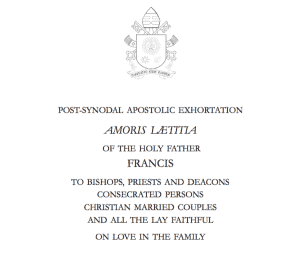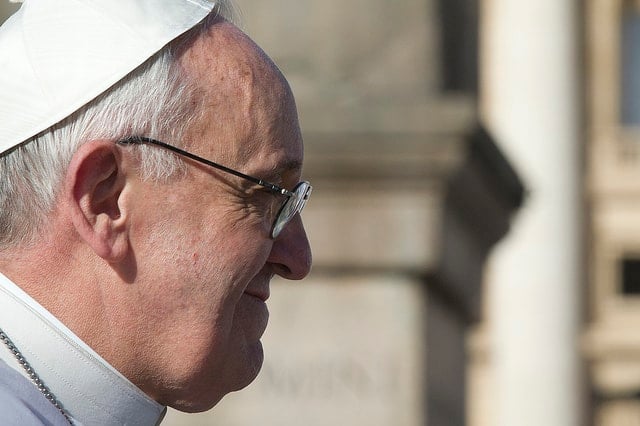“The joy of love experienced by families is also the joy of the Church.”
With these words, Pope Francis opens Amoris Laetitia, his exhortation on love in the family. The joyful and life-giving love of the family arises from the experience of the joyful and life-giving love of God. The Church’s teaching on the family, therefore, is in itself a joyful act. For that teaching is in the first place the passionate proclamation of the “Gospel of the Family,” the simple yet profound truth that God loves all persons in and through the family [63].
Amoris Laetitia, or “The Joy of Love,” is Francis’ highly anticipated apostolic exhortation on the “Synods on the Family” that met in the falls of 2014 and 2015. Those synods, which were meetings of bishops from all over the world, met amidst great expectations and concerns about the future of the family. Particularly controversial, at least in the West,1 were knotty issues surrounding the reception of communion by those who divorced and remarried.
As Francis’ “exhortation” on those synods, the document is his reflection on the proceedings of those meetings. But the pope goes far beyond the synods in this text. For while the bishops at the synods made many observations and recommendations, it was for Pope Francis to weigh in with the decisive conclusion to the proceedings.2
The document both exceeds and defies expectations. Indeed, Francis signals as much when he warns that too much commentary on these issues reflects either “an immoderate desire for total change without sufficient reflection or grounding,” or “an attitude that would solve everything by applying general rules or deriving undue conclusions from particular theological considerations” [2]. The pope rejects both.
So what has Francis given us? For one thing, an incredibly fragrant bouquet of Scriptural exegesis, moral exhortation, theological analysis, spiritual discernment, pastoral reflection, and old-fashioned advice-giving. It ranges from the magisterial to the avuncular, and often in the same paragraph.
One learns a great deal about the exhortation from its structure. The exhortation starts gradually and builds up to its central point, only then taking on the polemical and heated questions that engaged many onlookers of the synods.
In the introduction, the pope notes that Chapters 4 and 5 are “central.” They concern love. What comes before those chapters is meant to prepare for that discussion of love. Those chapters are on Scripture (1), the experiences of family today (2), and doctrine (3).3 Thus, before Francis moves to the core of the document, he has initiated a three-way dialogue between the Word of God, the world today, and Church doctrine. What shines through this dialogue is the joy of family life, the experience of God’s love that allows us to love others. This joy of love is central to Francis’ message. Francis acknowledges that the family faces tremendous difficulties in our time, but he also sees the continued witness to unconditional love that, despite the obstacles, so many families give:
I thank God that many families, which are far from considering themselves perfect, live in love, fulfilling their calling and keep moving forward, even if they fall many times along the way [57].
The “central” chapters, in turn, are a beautiful exposition of love in all of its forms. The two chapters are divided roughly between the unitive and procreative dimensions of marriage, but they are richly contextualized in the relationality of marriage to avoid being reduced to “functions” or “duties.” And while the emphasis is on marriage, one can see sideways glances to many other sorts of relationships, including that of the Church to the world.
It is only after these five chapters that Pope Francis moves to the “pastoral considerations” for which many anticipated the document.4 Most will be disappointed. On the one hand, Pope Francis affirms the doctrine of the Church. As he writes: “In order to avoid all misunderstanding, I would point out that in no way must the Church desist from proposing the full ideal of marriage, God’s plan in all its grandeur…” [307].
On the other hand, and not surprisingly, he thinks Church doctrine has been taught with the wrong emphasis:
Many people feel that the Church’s message on marriage and the family does not clearly reflect the preaching and attitudes of Jesus, who set forth a demanding ideal yet never failed to show compassion and closeness to the frailty of individuals like the Samaritan woman or the woman caught in adultery. [38]
Conversion requires an experience of mercy and forgiveness, an encounter with another that cannot simply be substituted by “a new set of general rules, canonical in nature and applicable to all cases.” Rather, the situation calls for “a renewed encouragement to undertake a responsible personal and pastoral discernment of particular cases” [300].
Pope Francis speaks with sympathy of those “who prefer a more rigorous pastoral care which leaves no room for confusion” [308]. But the deeper confusion, he argues, is one that obscures the primacy of love in the Church’s teaching of the Gospel. The pope makes this point many times over:
Our teaching on marriage and the family cannot fail to be inspired and transformed by this message of love and tenderness; otherwise, it becomes nothing more than the defence of a dry and lifeless doctrine. [59]
But I sincerely believe that Jesus wants a Church attentive to the goodness which the Holy Spirit sows in the midst of human weakness, a Mother who, while clearly expressing her objective teaching, “always does what good she can, even if in the process, her shoes get soiled by the mud of the street.” [308]
Francis nowhere denies the validity of Church doctrine. He wants to revisit, rather, how it ought to be applied in a way that mercifully re-incorporates people into the Church. Thus, he repeatedly invokes John Paul II’s “law of gradualism” [294].

Amoris Laetitia cover page
Throughout the text, the pope takes his own advice that the Church must (1) recognize the complexity of the contemporary family and (2) offer “truth and hope” [57]. Francis highlights this complexity from the beginning of the text, seeking to ensure that the Church’s understanding of that situation is “firmly grounded in reality” [6]. With this analysis of the family’s conditions, Francis can make clear that the causes of the family’s distress are diverse, and that no single response to them will prove a silver bullet.
The Church forms a critical part of that reality. But the Church has not always supported families, Francis argues. At times lacking humility and realism, the Church has too often been content “simply decrying present-day evils,” seeking “to impose rules by sheer authority” [35-6]. In turning us away from such attitudes, Francis constantly redirects our attention to the beauty and joy of married life and the family:
Nowadays we are grateful too for the witness of marriages that have not only proved lasting, but also fruitful and loving. All these factors can inspire a positive and welcoming pastoral approach capable of helping couples to grow in appreciation of the demands of the Gospel. Yet we have often been on the defensive, wasting pastoral energy on denouncing a decadent world without being proactive in proposing ways of finding true happiness. [38]
In all of this sober realism, however, lies real grounds for the “hope and truth” that Francis says the Church must proclaim. Indeed, emphasizing the difficulties of family life allows Francis to make a crucial point: “The Lord’s presence dwells in real and concrete families, with all their daily troubles and struggles, joys and hopes” [315]. God is with all of us, not only the sinless. He calls us to perfection, but He also cares for us in our frailties and weakness. As the title of Chapter 8 indicates, the Church is therefore called to accompany the weak, to discern with them and to integrate them into the Church.
We have left many topics in this exhortation unexplored: gender equality; the parallel between Trinitarian and familial communion; the relationship between work, poverty and nature; the deft handling of contraception; erotic love in married life; celibacy and virginity; and his “spirituality of the family”; and Francis’ fundamentally Ignatian engagement with Scripture. Further, as in Evangelii Gaudium and Laudato Si’, Francis shows a zealous enthusiasm for engaging with a panoply of thinkers, from Erich Fromm and Josef Pieper to Jorge Borges and Martin Luther King, Jr, along with numerous bishops’ conferences, St. Thomas Aquinas, Pope Leo the Great and, of course, St. Ignatius of Loyola.
In short, the text is vintage Francis. It is most appropriate that this exhortation should emerge in the context of the Year of Mercy. As Francis writes:
We cannot forget that “mercy is not only the working of the Father; it becomes a criterion for knowing who his true children are. In a word, we are called to show mercy because mercy was first shown to us”. [310].
Francis envisions the Spirit’s grace of mercy being implanted in our hearts. That merciful love, in turn, will change – heal, deepen, elevate – all that we are and do. For then we will see, know and love as God does. It is in that light we can make our own the Pope’s closing prayer:
Prayer to the Holy Family
Jesus, Mary and Joseph,
in you we contemplate
the splendour of true love; to you we turn with trust.
Holy Family of Nazareth,
grant that our families too
may be places of communion and prayer, authentic schools of the Gospel
and small domestic churches.
Holy Family of Nazareth,
may families never again experience violence, rejection and division;
may all who have been hurt or scandalized and ready comfort and healing.
Holy Family of Nazareth,
make us once more mindful
of the sacredness and inviolability of the family, and its beauty in God’s plan.
Jesus, Mary and Joseph, Graciously hear our prayer.
Amen.
******
For more of The Jesuit Post’s coverage on Amoris Laetitia:
Amoris Laetitia: Deciding to Love
10 Inspiring Quotes from Amoris Laetitia
You can also check out the coverage from our friends at America Magazine here.
-//-
Cover image courtesy FlickrCC user Jeffrey Bruno, available here.
- Commentators like Fr. Tom Reese, SJ, wondered whether the exhortation would address matters of especial concern to the Global South. Examples of that attention include Francis’ references to polygamy (53), genital mutilation (54) and dire poverty (49). ↩
- Thus, while an “exhortation” is not so weighty a document as an encyclical, the content of this exhortation assures it a ready audience. Moreover, given the impact of Francis’ first exhortation, Evangelii Gaudium, it is clear that Francis is willing to engage serious topics in this sort of text. ↩
- Notably, the chapter on doctrine is entitled “Looking to Jesus: The Vocation of the Family.” Francis locates the doctrine of the Church firmly in the “kerygma” of the Gospel. ↩
- Pastoral considerations feature significantly in Chapters 6 and 8, with Chapter 7 as an interesting interlude on the education of children. ↩


